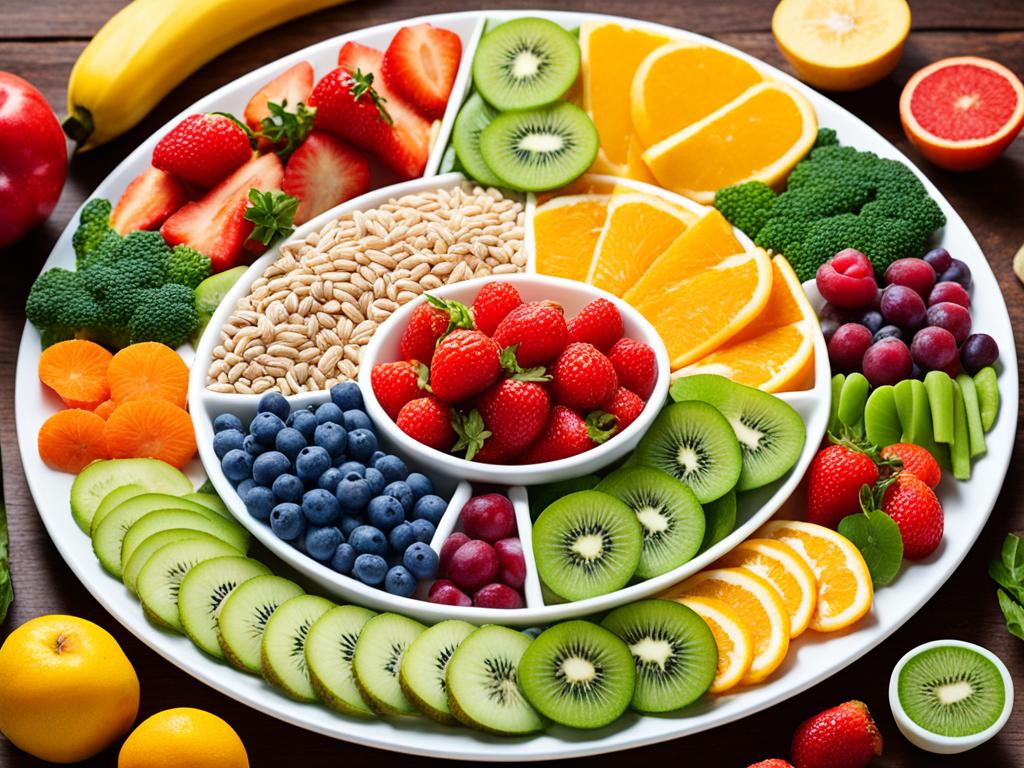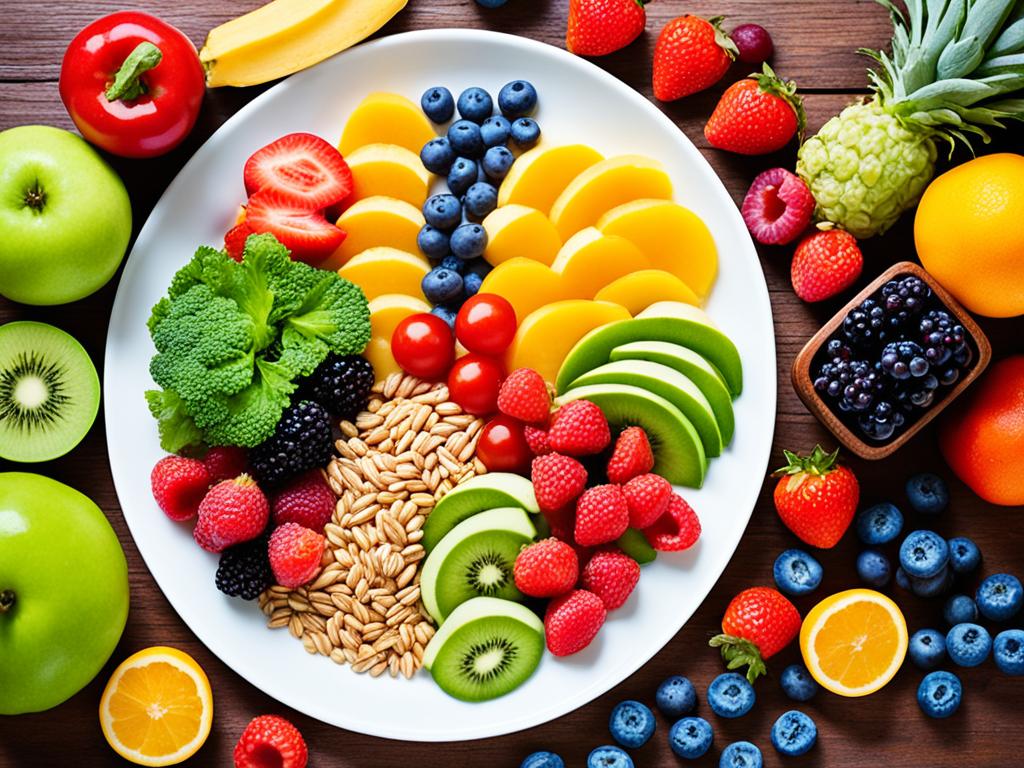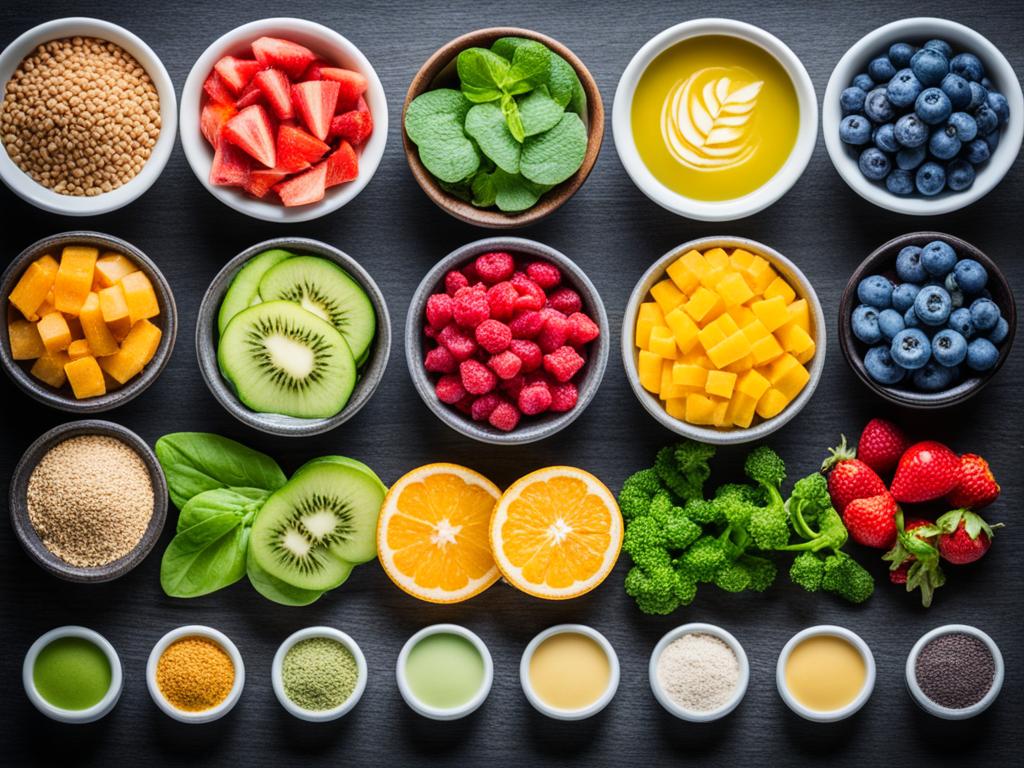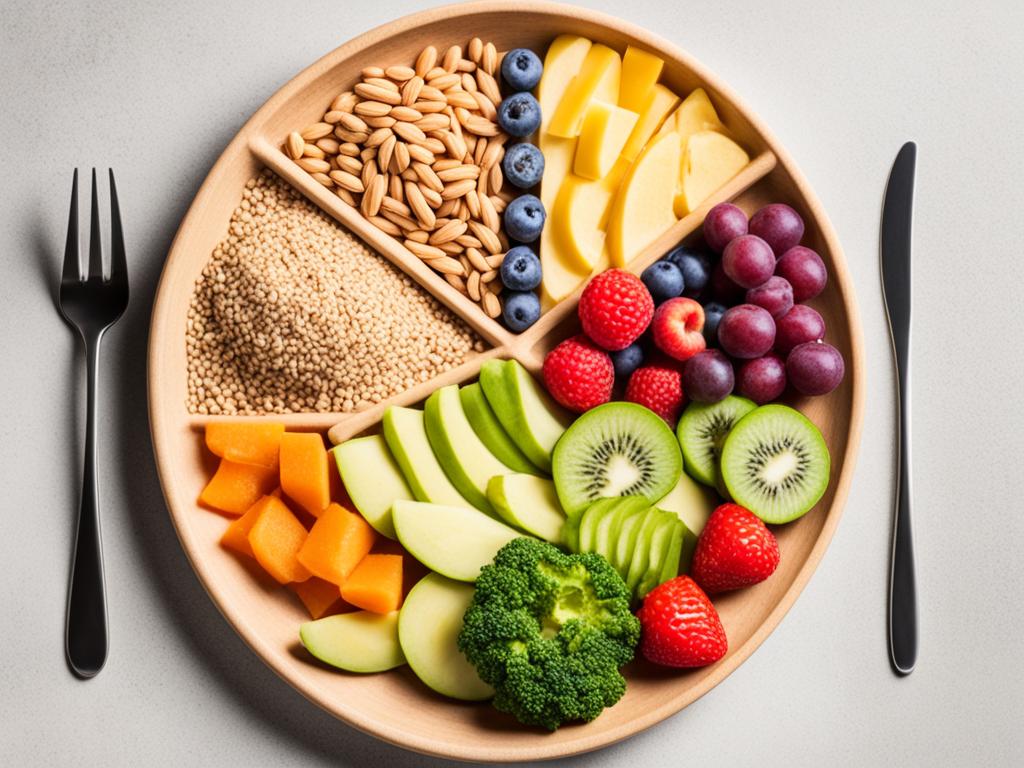
What is a Balanced Diet?
Keeping a balanced diet is key for good health and feeling great. A balanced diet means eating a variety of foods from different groups. These foods give you the right mix of nutrients your body needs to work well.
This guide will cover what a balanced diet is, why it’s important, and what foods are part of it. Learning about balanced diets helps people make better food choices. This supports their health and energy levels.

Understanding the Concept of a Balanced Diet
Keeping a balanced diet is key for good health. It means eating the right amount of nutrients. These include macronutrients and micronutrients. They help the body work well and keep you healthy.
Definition and Importance
A balanced diet has many nutrient-rich foods. This includes fruits, veggies, whole grains, lean proteins, and healthy fats. Eating well is vital. It helps you stay at a healthy weight, lowers disease risk, and gives you the energy you need.
Key Components of a Balanced Diet
The main parts of a balanced diet are:
- Macronutrients: These are protein, carbs, and fats. They give you energy and help with body functions.
- Micronutrients: These are vitamins and minerals. They keep you healthy and support your immune system.
- Food groups: Foods like fruits, veggies, whole grains, lean proteins, and dairy. They give you many nutrients and help with health.
Adding these to your diet makes sure you get the nutrients you need. It helps with your health and well-being.

The Food Groups and Their Roles
Keeping a balanced diet is key for good health. It’s all about eating a mix of different food groups. Each group has its own role in giving you the nutrients you need.
Fruits and Vegetables
Fruits and veggies are full of vitamins, minerals, and fiber. They have antioxidants and phytochemicals that help your immune system, keep your heart healthy, and lower the risk of diseases. Try to eat a variety of colors to get lots of nutrients.
Grains
Grains, especially whole grains, are packed with complex carbs, fiber, and B vitamins. They give you energy and help your digestive system. Eat a mix of whole grains like whole wheat, brown rice, and quinoa for the best benefits.
Protein
Protein-rich foods, like lean meats, poultry, fish, eggs, legumes, and nuts, are vital for building and fixing tissues, keeping muscle mass, and supporting your body’s functions. Switching up your protein sources makes sure you get all the amino acids you need.
Dairy
Dairy items, like milk, yogurt, and cheese, are great for calcium, which is important for strong bones and teeth. They also have protein, vitamin D, and riboflavin. Choose low-fat or non-fat options to keep your calories in check.

Eating a mix of food groups helps make sure your body gets all the nutrients it needs. Remember, it’s all about balance and moderation for a healthy diet.
Macronutrients: Protein, Carbohydrates, and Fats
Understanding macronutrients is key to a balanced diet. These three nutrients give us energy: protein, carbohydrates, and fats. Let’s explore each one’s role.
Protein Sources and Functions
Protein is vital for fixing and building tissues and supporting the body. Great protein sources are lean meats, poultry, fish, eggs, legumes, and dairy. It keeps muscles strong, helps with healthy skin and hair, and boosts the immune system.
Carbohydrates: Simple vs. Complex
Carbs are our main energy source. There are simple and complex carbs. Simple carbs like sugars give quick energy. Complex carbs, found in whole grains, fruits, and veggies, give steady energy and more nutrients.
| Macronutrient | Sources | Functions |
|---|---|---|
| Protein | Lean meats, poultry, fish, eggs, legumes, dairy | Tissue building and repair, muscle maintenance, immune support |
| Carbohydrates | Simple: Sugars Complex: Whole grains, fruits, vegetables | Simple: Quick energy Complex: Sustained energy, additional nutrients |
| Fats | Oils, nuts, seeds, avocados, fatty fish | Energy storage, hormone production, nutrient absorption, insulation |

Micronutrients: Vitamins and Minerals
Micronutrients like vitamins and minerals are key for good health. They are small but very important. They help keep our bodies working right.
Essential Vitamins and Their Benefits
Vitamins are needed in small amounts. They help with many important tasks. For example, vitamin C helps fight off sickness and keeps cells healthy. Vitamin D is important for strong bones and getting enough calcium.
- Vitamin A: Supports eye health, immune function, and skin health.
- Vitamin B Complex: Aids in energy production, nervous system function, and red blood cell formation.
- Vitamin C: Boosts immunity, promotes collagen production, and acts as an antioxidant.
- Vitamin D: Crucial for bone health, calcium absorption, and immune function.
- Vitamin E: Functions as an antioxidant, supporting cardiovascular health and skin health.
Crucial Minerals for Overall Health
Minerals are also needed in small amounts. They help with many important tasks. Iron is key for carrying oxygen in the blood. Zinc helps with fighting off sickness and healing wounds.
| Mineral | Function |
|---|---|
| Calcium | Supports bone and teeth health, muscle function, and nerve transmission. |
| Iron | Crucial for the transportation of oxygen in the blood and the production of red blood cells. |
| Magnesium | Involved in over 300 enzymatic reactions, supports muscle and nerve function, and bone health. |
| Zinc | Supports immune function, wound healing, and protein synthesis. |
Learning about micronutrients, like vitamins and minerals, helps us make better food choices. This way, we can get the right amount of vitamin and mineral benefits for our health.

Balanced Diet and Portion Control
Getting a balanced diet means picking the right nutrients and watching how much you eat. It’s key to keep a healthy weight and make sure your body gets all it needs. Portion control is a big part of this.
The Dietary Guidelines for Americans say controlling portions is vital for a balanced diet. They suggest certain serving sizes for each food group. This helps people get the nutrients they need without eating too many calories.
- Grains: 1 slice of bread, 1/2 cup of cooked rice or pasta
- Fruits and Vegetables: 1 cup of raw or cooked vegetables, 1 medium-sized fruit
- Protein: 3 ounces of cooked lean meat, poultry, or fish
- Dairy: 1 cup of milk or yogurt, 1.5 ounces of cheese
By planning your meals with portion control in mind, you can make sure your diet has the right mix of nutrients. This helps you stay at a healthy weight, lowers the risk of diseases, and keeps you feeling full of energy.
| Food Group | Recommended Portion Size |
|---|---|
| Grains | 1 slice of bread, 1/2 cup of cooked rice or pasta |
| Fruits and Vegetables | 1 cup of raw or cooked vegetables, 1 medium-sized fruit |
| Protein | 3 ounces of cooked lean meat, poultry, or fish |
| Dairy | 1 cup of milk or yogurt, 1.5 ounces of cheese |
By planning your meals with portion control, you can make sure your diet has the right nutrients. This helps you stay at a healthy weight, lowers the risk of diseases, and keeps you feeling full of energy.
Meal Planning for a Balanced Diet
Planning meals is key to a balanced diet. It’s not just about what we eat, but how we plan and prepare our meals. By using smart tips and habits, we can easily fit a balanced diet into our daily life.
Tips and Strategies for Meal Planning
Start by knowing what a balanced diet includes. Add foods from all groups like whole grains, lean proteins, fruits, veggies, and healthy fats. Here are some tips to help you plan better:
- Plan meals ahead with a weekly or monthly menu for balanced nutrition.
- Batch cook or prep meals early to save time and avoid unhealthy choices.
- Try new recipes and cooking methods to keep meals exciting.
- Use smaller plates and measure food portions to control them.
- Prep ingredients or assemble meal parts early to make cooking easier.
Incorporating Lifestyle Habits for a Balanced Diet
It’s not just about the food; it’s also about our lifestyle. Adding healthy habits to our daily life helps with a balanced diet:
- Regular Physical Activity: Regular exercise or active hobbies helps control appetite, boosts metabolism, and improves well-being.
- Mindful Eating: Being present and attentive during meals makes food more enjoyable and helps with portion control.
- Hydration: Drinking plenty of water supports the body’s functions and helps with digestion.
- Stress Management: Using stress-reducing techniques like meditation or yoga helps control emotional eating and supports balanced nutrition.
By using meal planning tips and healthy habits, we can make a balanced diet and better well-being easier to achieve.

Conclusion
This article has covered the basics of a balanced diet and its importance. We’ve looked at the main food groups and the role of different nutrients. It aims to help you understand how to eat for better health and well-being.
Learning about portion control and meal planning is key to a balanced diet. These skills help manage weight and prevent chronic diseases. They make life more vibrant and fulfilling.
A balanced diet is more than just counting calories or cutting out foods. It’s about finding a way to feed your body, mind, and spirit in a healthy way. Try to eat a variety of whole, nutritious foods. Start this journey to better health and see the many benefits a balanced diet brings.
FAQ
What is a balanced diet?
A balanced diet means eating a variety of foods in the right amounts. It gives you the nutrients you need for good health. This includes proteins, carbs, fats, vitamins, and minerals from different foods.
Why is a balanced diet important?
Eating a balanced diet keeps you healthy and supports growth. It also lowers the risk of diseases like heart disease and diabetes. It makes sure your body gets all the nutrients it needs.
What are the key components of a balanced diet?
A balanced diet has: – Macronutrients: Protein, carbs, and fats – Micronutrients: Vitamins and minerals – Foods from various groups: Fruits, veggies, whole grains, lean proteins, and dairy or alternatives
What are the food groups and their roles in a balanced diet?
The main food groups are: – Fruits and veggies: Give you vitamins, minerals, and fiber – Grains: Have complex carbs, fiber, and B vitamins – Proteins: Help build and repair body tissues – Dairy or dairy alternatives: Keep bones and teeth strong – Healthy fats: Support brain and heart health
What are the different types of macronutrients, and how do they contribute to a balanced diet?
The three main macronutrients are: – Protein: In foods like meat, fish, eggs, and beans, it helps muscles grow and repair. – Carbohydrates: In grains, fruits, and veggies, they give you energy. – Fats: In nuts, avocados, and olive oil, they help brain function and heart health.
What are the essential vitamins and minerals, and how do they benefit the body?
Important vitamins and minerals include: – Vitamins: A, C, D, E, and B-complex, which help with immune function, skin health, and energy. – Minerals: Calcium, iron, magnesium, and potassium, crucial for bone health, making red blood cells, and muscle and nerve function.
How can portion control help maintain a balanced diet?
Controlling portions is key for a balanced diet. Use measuring cups and plates to help you eat the right amount of each food group. This prevents overeating and ensures you get the right nutrients.
What are some tips for meal planning to support a balanced diet?
For meal planning, try these tips: – Include foods from all groups in your meals. – Cook with whole ingredients at home. – Listen to your body’s hunger and fullness signals. – Drink plenty of water and stay active.



Balance diet is very essential for the human system and keeps the immune system strong